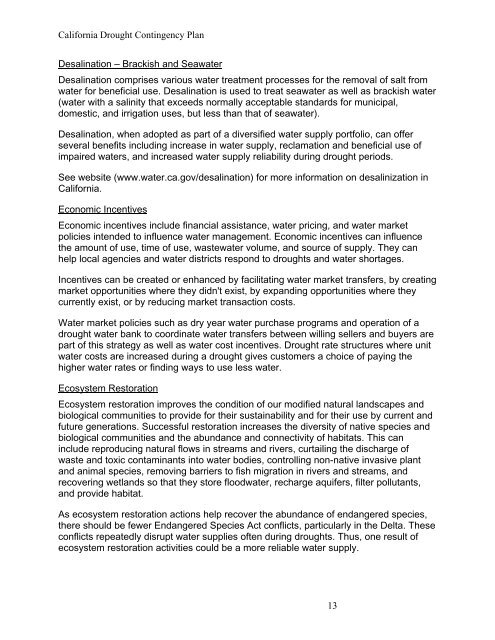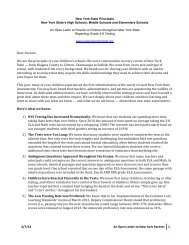Final_CA_Drought_Contingency_Plan-11-18-2010a
Final_CA_Drought_Contingency_Plan-11-18-2010a
Final_CA_Drought_Contingency_Plan-11-18-2010a
You also want an ePaper? Increase the reach of your titles
YUMPU automatically turns print PDFs into web optimized ePapers that Google loves.
California <strong>Drought</strong> <strong>Contingency</strong> <strong>Plan</strong>Desalination – Brackish and SeawaterDesalination comprises various water treatment processes for the removal of salt fromwater for beneficial use. Desalination is used to treat seawater as well as brackish water(water with a salinity that exceeds normally acceptable standards for municipal,domestic, and irrigation uses, but less than that of seawater).Desalination, when adopted as part of a diversified water supply portfolio, can offerseveral benefits including increase in water supply, reclamation and beneficial use ofimpaired waters, and increased water supply reliability during drought periods.See website (Hwww.water.ca.gov/desalinationH) for more information on desalinization inCalifornia.Economic IncentivesEconomic incentives include financial assistance, water pricing, and water marketpolicies intended to influence water management. Economic incentives can influencethe amount of use, time of use, wastewater volume, and source of supply. They canhelp local agencies and water districts respond to droughts and water shortages.Incentives can be created or enhanced by facilitating water market transfers, by creatingmarket opportunities where they didn't exist, by expanding opportunities where theycurrently exist, or by reducing market transaction costs.Water market policies such as dry year water purchase programs and operation of adrought water bank to coordinate water transfers between willing sellers and buyers arepart of this strategy as well as water cost incentives. <strong>Drought</strong> rate structures where unitwater costs are increased during a drought gives customers a choice of paying thehigher water rates or finding ways to use less water.Ecosystem RestorationEcosystem restoration improves the condition of our modified natural landscapes andbiological communities to provide for their sustainability and for their use by current andfuture generations. Successful restoration increases the diversity of native species andbiological communities and the abundance and connectivity of habitats. This caninclude reproducing natural flows in streams and rivers, curtailing the discharge ofwaste and toxic contaminants into water bodies, controlling non-native invasive plantand animal species, removing barriers to fish migration in rivers and streams, andrecovering wetlands so that they store floodwater, recharge aquifers, filter pollutants,and provide habitat.As ecosystem restoration actions help recover the abundance of endangered species,there should be fewer Endangered Species Act conflicts, particularly in the Delta. Theseconflicts repeatedly disrupt water supplies often during droughts. Thus, one result ofecosystem restoration activities could be a more reliable water supply.13






